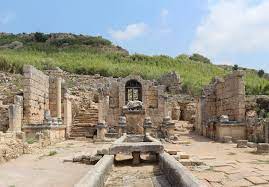Serif tells about Pamphlia – Heritage Magazine – Summer 2005
Serif Yenen In this magnificent article published in Heritage Magazine – Summer 2005 issue; It describes Perge, Pamphlia and Plancia Magna. In this delightfully read article, BC. It goes back to the 1st century and we read the story from the pen of Serif.
“Live on, Perge! The Glorious city of Pamphlia”
(From a poetic inscription written in the 3rd century AD in the street to the north of the agora)
 Perge, one of the most prominent cities of the Pamphylia region since ancient times, still fascinates visitors with its beauty and ruins of the past. Its heyday was during the Hellenistic Period, when its people praised it with such phrases as, “untouchable home” and “glorious city of Pamphylia”.
Perge, one of the most prominent cities of the Pamphylia region since ancient times, still fascinates visitors with its beauty and ruins of the past. Its heyday was during the Hellenistic Period, when its people praised it with such phrases as, “untouchable home” and “glorious city of Pamphylia”.
Prof. Dr. Haluk Abbasoglu, who has been leading excavations here since 1988, pointed out in his article published in Istanbul Magazine, that this has been the feeling for Perge throughout the ages.
Perge remained a shining star in Pamphilia (land of all tribes) during the Hellenistic and Roman Periods, along with four other important cities of the region: Attaleia (Antalya), Sillyon (Asar Village), Aspendus and Side . Perge was captured by Lydians at one time and by Persians at another; it was home to the armies of Alexander the Great; it was passed to the Kingdom of Pergamum, and then joined the Roman Empire. As a result, many myths originated in Perge, depicting it as a symbol of wealth and civilization.
Pamphlia
One of the primary notables who introduced this city to the whole world over the course of history was Apollonius. Apollonius, the greatest master of geometry of all times, lived in Perge ca. 2nd century BC. Though nothing much is known about his life, the works of Apollonius, especially his book “Conics”, made a great impact on the development of mathematics. As the first person to use the terms ellipse, hyperbola and parabola, Apollonius was one of the founders of ancient mathematical astronomy, which applied geometrical models to the planetary system. Another aspect that contributed to the historical importance of Perge was that Saint Paul and Barnabas started their journeys in Anatolia from Perge. Marking a milestone in the history of Christianity, this event makes Perge prominent with respect to religion. The first person who mentioned this city, which maintained its importance until the Byzantine Middle Ages, was a geographer named Pseudo-Skylax who lived in the 4th century BC. Pamphlia
A short tour in Pamphlia
The people of Pamphlia believed that this city had been founded by Achaean warriors who went southward to find a way to return to their home after the Trojan War. The inscription found on the pedestal of a sculpture dated 2nd century AD, stating, “Founder, Calchas of Argos, son of Thestor” and “Founder, Mopsus of Delphi, son of Apollo” verifies this belief; however, research shows that the history of Perge extended to a time earlier than the Trojan War. Unlike other significant centers in Pamphilia, such as Side and Aspendus, the name Perge does not originate from Hellenic but from the native Anatolian language. The fact that Artemis Pergaia, the famous goddess of Perge, is not a Hellenic goddess also indicates that the city dates back to a period earlier than the arrival of Achaeans, as pointed out by Mr. Abbasoglu. The legendary Temple of Artemis or “Goddess of Perge”, for which Pamphlia is also famous, has not yet been unearthed.
Almost all the ruins remaining today, such as the theater, stadium, agora, bath, fountain, and columned street, belong to the Imperial Era of the city, when it was a Roman colony, after the 1st century AD. Visitors to the ruins of Perge first encounter the theater and stadium. Perge’s theater was one of the most elaborate in Anatolia, with the outer facade of its stage building standing 12 meters high and housing a monumental fountain. With a seating capacity of 12,000 spectators, Perge’s stadium is one of the three best-preserved stadiums in Anatolia, the other two being in Aphrodisias and Laodicea.
After the theater and stadium you arrive at the main entrance to the city. The entrance is ornamented by first the Roman Gate of the 4th century AD, and then the Hellenistic Gate of the 3rd century BC, consisting of two round towers. In the wide area between those two are the baths and monumental fountains of the Roman Period. The colonnades on both sides of the 20 meter wide Columned Street, together with the water channel in the middle of the street, are the most striking features of Perge. The channel was built not only to carry potable water or discharge waste water, but also as a cooling device for hot summer days, providing rest and tranquility with its soothing sound and the reflection of the sun. This is considered extraordinary for an ancient city. The Columned Street intersects with the other main streets and extends from the Hellenistic Gate to the Monumental Fountain.
The agora of Perge is a small, square area surrounded by rows of columns and shops. Right in the center there is a round building dedicated to Hermes, the god of merchants, or to Tyche, the goddess of fortune. You can still see the traces of the ancient shops here. The marble block with a relief of hook and knife at the northeast end of the agora shows that there used to be a butcher shop here, and that basic human needs do not change much despite the centuries.
Plancia Magna
Behind the twin towers, which fascinate the visitors with their attractive appearance, we see an area built in the beginning of the 2nd century AD. This is a horseshoe-shaped courtyard and Monumental Gate, built in honor of Plancia Magna and decorated with statues of gods and founders of the city. Plancia Magna, a name identified with the city, was the most powerful woman of the city, who assumed important responsibilities and performed public services. She came from the Plancii family who gained importance during the Roman colonization in Perge. It is thought that Plancia Magna, who is mentioned as a charitable personality of Perge in many places of the city, was the wife of M. Plancius Varus, who was a senator during the reign of Nero and the proconsul of Bithynia during the reign of Vespasian. Most probably her wealth came from her family and she took control of it. Her mother, who was one of the priestesses of Artemis, the most important goddess of the city, made her powerful also in the area of religion, such that she assumed the titles of magistrate, school principal, priestess of Cybele, Artemis and the Empire Cult, benefactress of the city, and “demiurge” which is the highest civil service in the city’s management.
Underlying Plancia Magna’s spending so much time and money on this magnificent building was the tradition of doing works of charity, though not always voluntarily. The tendency was to show off one’s affluence, and compete against neighboring cities. In the same period, the Roman Emperor Hadrian, who was known for his admiration for Hellenistic culture, started the festivities in Athens called “Panhelleneia” for political unity based on collective consciousness, history and culture. The privilege to join the celebrations was only granted to cities that proved their Hellenistic origin. Many Anatolian cities raced to prove their Hellenistic origin with made-up myths, in order to seize this privilege. Those endeavors explain why the buildings in the city were sponsored by Plancia Magna.
Another factor lies hidden in the time of the “Pax Romana” which lasted about two hundred years. While the importance of warriors declined in this imperial age when Rome turned into an open city and had not a single civil war, piracy and rioting were on the uprise. Women gained increasing autonomy. Many services, which were previously done by men in Roman cities, started to be assumed by the women of local noble families. Previously, the noble women of Rome had had no political rights, had lived under the control of their fathers or husbands, and had had the main task of managing housework as the “matron”. Now they started to assume more active positions. Many religious tasks and public improvements in the cities of the Empire were conducted and sponsored by noble women such as Plancia Magna of Perge.
On two sides of the oval courtyard are 14 separate niches for statues, seven of which represented mythological figures and seven the city’s contemporary founders, most likely the Plancii family. What is significant is the fact that the statues of women outnumber the men, which correlates with the number of women in higher positions at the time.
Women of royal blood set the example for the local women. A woman’s reaching such significant level and power is in fact not surprising at all in Anatolia. When we take a look at the Anatolian woman through the ages we can see her in different roles, such as, goddess, magistrate, or warrior. The Major Goddess, the trade magistrates in Kültepe (2000 BC), the magistrates of Priene, the Amazon warriors, and the trained soldiers whom warriors married by order of Alexander the Great after the conquest of Miletus, were all women. The women of Lydia chose their husbands; the women of Miletus refused to sit at the same table with their husbands and address them by their names when Neleus, the legendary founder of Miletus, forced the women of the city to marry the newcomers; and, the women of Xanthos killed themselves rather than surrender to the Persians (545 BC). These are but some of the legends told in Anatolia. Centuries later, a woman named Plancia Magna reached the peak of her power in Perge, and made her name and other notables of her choice immortal, together with Perge.
If you would like to visit Pamphlia under the guidance of Serif, please contact us.




